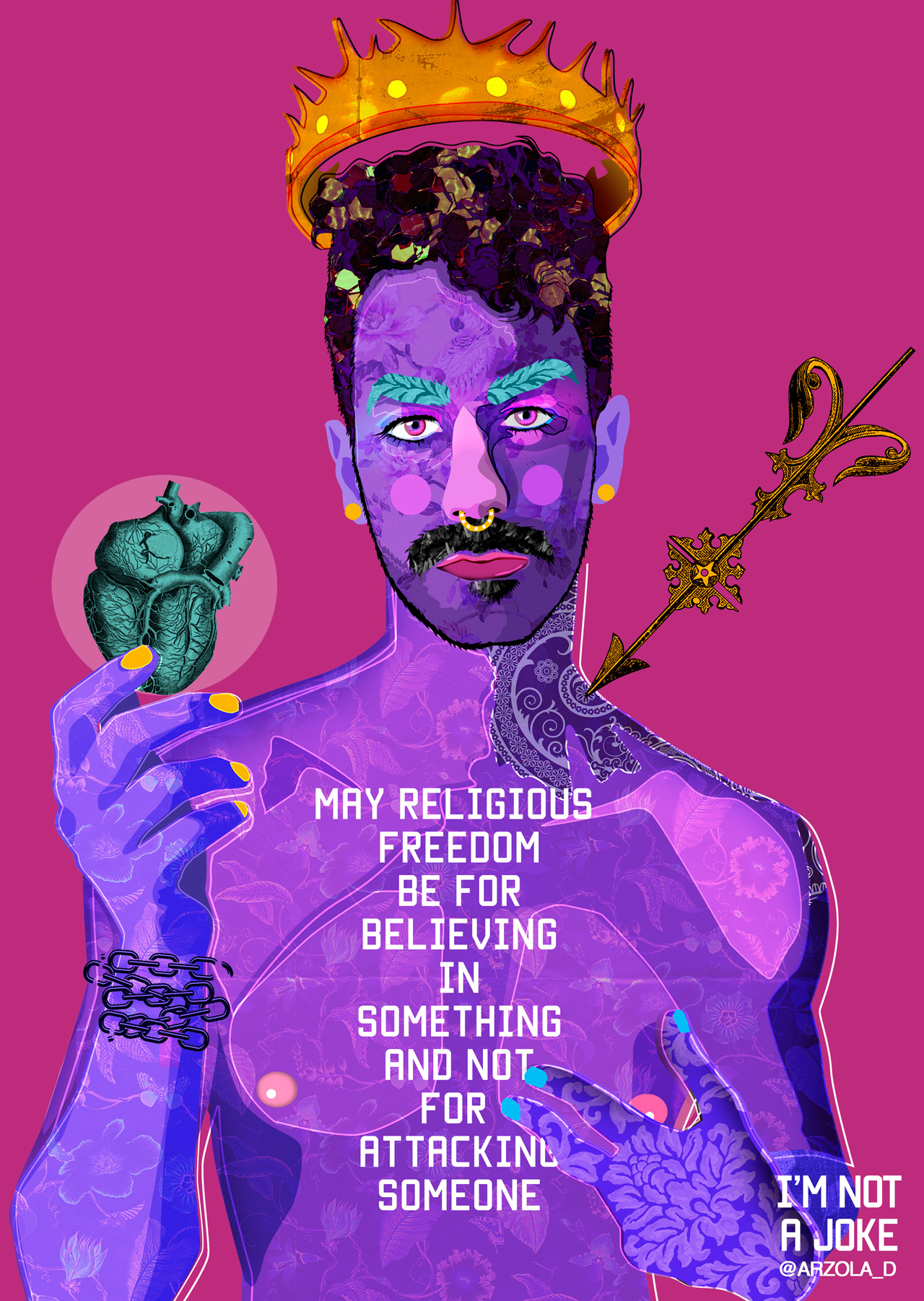Aged just 15, Daniel Arzola was tied to a pole, attacked with cigarettes and threatened to be burned alive by his homophobic neighbors in Maracay, Venezuela. As a young man with a passion for art, he was also forced to have his drawings destroyed. The trauma of the event saw Arzola withdraw from his passion for many years.
Delving deeply into the artist’s personal experiences, which include being the target of hate crimes on multiple occasions, Arzola’s contemporary work explores notions of gender and LGBTIQ+ rights. No be you chiste (“I’m No Joke”), a series of posters featuring colorful illustrations accompanied by powerful messages that tackle complex issues of civil liberties and identity, strives to challenge stereotypical portrayals of LGBTIQ+ community. Slogans such as “If you say you respect me but I can’t have the same rights as you, then you don’t respect me” reaffirm an individual’s right to dignity, above all else, and act as a form of resistance to societal oppression. standards.
Having seen much of his physical artwork targeted by fanatics, Arzola turned to the digital landscape to give his work a permanence and security that paper does not offer. “Growing up in Venezuela, my work was repeatedly destroyed,” he recalls. “I understood that art can be fragile. Now that my work is digital, however, it has become more accessible than ever because you can destroy the medium, but the work can be reproduced again, here or anywhere else in the world. Thus, the message endures and the work becomes indestructible. This is “artivism” for me. »

This notion of artivism is key to Arzola’s work and one that has seen him garner social media praise from Madonna, Cyndi Lauper and Katy Perry. “The basic idea of the word ‘artivism’ has been shared since the late 20th century, referring to those artistic works that explicitly engage with a social context,” explains Arzola. “For me, art is always social because it depicts the behavior of human beings as a response and proof of the different situations articulated by society. Art allows us to talk about who we are and where we come from. It presents us with ideas that transcend and allow us to share statements as a community. It must be accessible and it must be seen. A museum filled with works but never visited is only a tomb.
Arzola recognizes that accessibility in art remains an issue and continues to champion exhibition outside of traditional gallery systems. “I grew up in a place with no museums, cinemas or art galleries,” he says. “But the internet has changed that dynamic. I think I first went online when I was 13, and today it’s become my primary workspace because of the accessibility of knowledge and information. Social media and the internet allow us to democratize art and bring it to everyone, connecting one or more worlds. One day, Madonna may tweet the work of a young queer person who grew up in a poor neighborhood in Venezuela. Then everything changes, because the dynamic that separated us disappears for a moment, and you, who have felt invisible all your life, suddenly feel that the world has noticed you, and this is the first step towards the growth.

Since 2017, Arzola has also presented a permanent exhibition, a 14-meter mural, in the Buenos Aires metro. “The station is named after Carlos Jáuregui, an LGBTIQ+ civil rights activist in Argentina. I think it’s important to be able to feel represented in the culture, in public spaces, to see that there are people like you who are facing similar situations. Art plays a fundamental role in the construction of our identity, especially at a time when the personal has become political,” says Arzola. “Art has the ability to disseminate the testimony of a person or a group of people and make it accessible to others. Art is knowledge. If we pay attention to it, we will understand art as a testimony to the history of mankind. From Molière’s theater to the art generated during the industrial revolution; of Federico García Lorca depicting the massacre of the Spanish Civil War in his poetry; to the photography of Lewis Hine and his portraits of working children; Mexican muralism; the dancing works of Keith Haring during the AIDS pandemic, or a novel by Reinaldo Arenas showing the hell created by Fidel Castro in Cuba. Art is social when it tells the realities we face together. It has the power to document the social struggles of our time. Art is political because it carries within it a message that survives the one who created it. History is usually written by those who won the war, for those who got power and didn’t want to share it, but art can be made by anyone, anywhere.
Check out more of Daniel’s work on his website and instagram. You can also support his work on Patreon.
LEARN MORE: EXPLORE THE “NEW WAYS OF SEEING” SERIES HERE